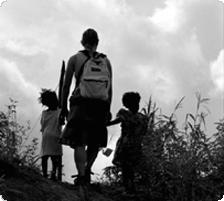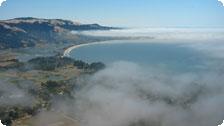by Marie-Jo Mont-Reynaud
Dèyè mòn gen mòn, a Haitian proverb, says that “behind mountains there are more mountains.” My photo, like the Creole phrase, has several layers of meaning. At first glance, two children gaze peacefully upon the vastness of the Haitian countryside, an infinite space of possibilities. But I look at this photo through a darker lens, because I spent three months in Haiti documenting peasants’ lives through photography.
Because I lived with these children, Destin and Jezilen, I know that they face an unforgiving landscape of insurmountable hills and future obstacles. In this photo, Destin and Jezilen are not just standing on the edge of the mountain; they are living on the edge as well. It is a condition I feel compelled to change.
Living with Destin and Jezilen’s family gave me a deeper understanding of life in Haiti. Every evening, the entire family would shell beans together and share stories by candlelight. Mr. Jean, the family’s patriarch, often told anecdotes revealing his knowledge of Haiti’s political problems. When we gathered on my last night there, I told the family that I would like to visit them again in the future. “Bon,” Mr. Jean responded in Creole. “It was great to have you. But maybe after you visit next year, you can help us see your country. We’ll need money for a plane ticket and help getting a passport and visa.” Caught off guard, I struggled to explain that as a sixteen-year-old, I could not provide visas for his family. But he persisted. “Please…maybe you could ask your parents or friends who work in the government if they could help us?”
The desperation in his voice made me uncomfortable, so I ended the conversation quickly. I lay in bed, disillusioned and confused. What could reduce such a proud man to beg in front of his family? Later, I related this experience to an aid worker in the area. He did not provide the comfort I sought but gave me the taste of reality I needed. “Sometimes in Haiti,” he explained, “your pride is the only thing you have to eat.”
I finally began to see Haiti and the effect of poverty on its people. The children in my Haitian family did not go to school; instead, they spent their days working in the fields. Their future had been decided for them already. I spent time face-painting, playing games, and teaching French to Haitian children, but in such conditions, no amount of smiling and laughter would have a lasting impact on their lives. The joy I felt painting flowers onto a girl’s gaunt face vanished with the realization that any effect I had on her life would likely not endure after the colors washed off.
My outlook has been shaped by my mother’s experiences as a graduate student researching orphans in Vietnam. In an orphanage one day, my mother betrayed her professional obligation to remain objective, and fell in love. A month-old baby stared up at her from his bed. My mother picked him up and did not put him down, knowing what his future would be if she walked away. Overcome with the desire to change his life, she adopted him as her own. To this day, my mother speaks of that baby, now my older brother, without regret. “I couldn’t save them all,” she says, “but I saved one.”
In the light of my mother’s story, I look at my photo and see two Haitian children facing the bleakness of their future, lit only by the last shimmer of the fading sun. I see Haiti’s harshness and feel despair, but I also see its beauty and have hope that the sun will rise above the mountains again. I don’t know exactly what I will do for the children of Haiti, but following my mother’s example, I know one thing I will not do: nothing.
About the Author
I am a sophomore at Stanford University, designing my own major in Visions of International Development, which incorporates international relations, anthropology, art, and communications. I am pursing this major due to my interest in journalism in all forms—writing, photography, and documentary film, and my desire to use journalism to address the social, political, and economic issues of developing countries.
I was born and raised in Palo Alto, California, the youngest of three children. My oldest brother, Gabriel, was adopted in Vietnam during the war. In many ways, it is thanks to my mother’s experiences in Vietnam as an anthropologist that I was first able to pursue my interest in studying and photographing developing nations. I began to research Haitian history for a project in high school and decided to visit the country I was writing about. Raised in a bilingual family (my father is French), and attending a French-American school until high school, I picked up Haitian Creole quickly through immersion.
I first went to Haiti when I was 15, and thus began my career in photography. I had never taken a photography class or taken pictures seriously, and it had not been my intention to start a career in photography by going to Haiti, but people reacted strongly to my photos when I returned. Maybe I’d been so close to the material that I didn’t realize how striking it was. But when I stepped back and saw how powerful photography could be, I decided to pursue it more seriously, so that what I saw among the people of Haiti could be shared more widely.
That is also why I have been returning to Haiti every summer since I was fifteen. I have come to call the area I frequent, “My Mountain,” which is the title of my first documentary film, produced during the winter of my freshman year at Stanford. I am now working on my second documentary, about Haitian immigrants in the Dominican Republic, and running a club for Stanford students interested in Haiti. I hope to return to Haiti again this summer to pursue more photography, and to lead another group of students to the mountains for a service project. I would also like to look at the country’s problems more broadly by working with an NGO or a state agency.
Some of my work can be seen at www.stanford.edu/~matrotz/maryjo







